Porcelain Insulator News
by Elton Gish
Reprinted from "Crown Jewels of the Wire", July 1997, page 12
We haven't discussed multipart porcelain insulators since November 1996 CJ.
It is time to catch up on a few interesting reports of multiparts. I will put a
couple of color photos on the web page at www.insulators.com/cjphotos/index.htm
for those of you on the internet.
Jeff Hogan stopped by recently and, as always, had some interesting
insulators to show. I have seen a number of M-2052 unmarked Thomas insulators and
all of them had a straight-sided bottom skirt that flares out slightly. Some of
these, too, have a Thomas "blue-jean seam" mark inside the bottom
skirt. Jeff's insulator has the "blue-jean seam" and a small
lily-shell bottom skirt. At first I thought this style should get a new M-number,
but on closer inspection of the drawing for that style in my book, Multipart
Porcelain Insulators, you will see that the catalog drawing shows this
lily-shell skirt feature. The catalog drawing shows the bottom skirt to be three
inches in diameter just like Jeff's insulator while all the straight-sided
specimens measure slightly more than 2-3/4 inches in diameter. That really is not enough difference to assign a new M-number to
the straight-side variety but you should be aware that there are two different
variations. Jeff's insulator is the first one I have seen that has this
prominently flared bottom skirt.
 |
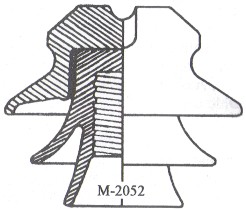 |
|
M-2052 N-N Thomas with lily-shell bottom skirt |
Jeff has a fantastic collection of early
porcelain insulators which includes some super multipart insulators. He had a
number of them in his display at the March 1996 Metroplex Insulator Show in the
Dallas area (a great show that is growing each year in both size and
walk-through attendance). Jeff has a M-3460 with three "blue-jean
seams" in the bottom skirt! This is very unusual because all previously
reported Thomas insulators had either one or two "blue-jean seams".
The three characteristic Thomas "blue-jean seams" (circa 1905-1915) on
Jeff's M-3460 were equally spaced dividing the interior of the bottom skirt in
thirds. The glaze is dark mahogany so don't know if the photo will reproduce
well enough here for you to see the "blue-jean seam" lines.
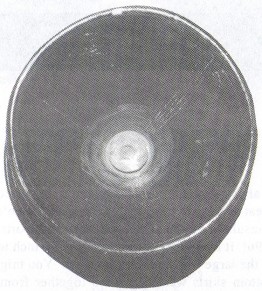
Inside view of the bottom skirt of Thomas M-3460 showing
the pattern of the
unique three "blue-jean seam" feature.
Jeff has two other early Thomas insulators with beautiful glazes. One is a
N-N M-3230 with a very pretty rust and mustard colored glaze. The glaze color
dates it to circa 1907-1910. Note the large glazed-over dent or factory-made
chip in the top skirt edge. This unique feature was also on Tim Wood's (NIA #1099)
M-2510 shown in September 1996 CJ. The other one
shown in the photograph is N-N M-2450. You'll have to check out the July CJ web
page to see it in color. The top skirt is a beautiful slightly reddish, light tan
glaze and the bottom skirt is mahogany -- a dramatic contrast! A unique feature
is the two shells were put together with sulfur cement. Both the M-3230 and
M-2450 have "blue-jean seams" .
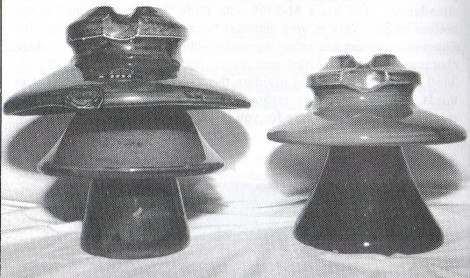
Unmarked early Thomas multiparts:
M-3230 (left) and M-2450 (right).
Ben Kirsten is always looking for unusual multipart porcelain insulators and
he has a great collection to show his successes. Ben's next report is another
super insulator in the realm of early multiparts which I have assigned M-2996!
It looks odd at first with the 14-inch top skirt similar to M-3740 and the large
lily-shell bottom skirt. You might suspect that the top and bottom skirts were
cemented together from two different insulator styles; however, Ben assures us
that the insulator IS in its original form and it even has the original cast
iron pin cemented in the bottom skirt. It appears that M-2996 was made up of the
top and middle skirt of M-3740. The pin is rather massive and probably needed the
larger opening of the middle skirt to receive it. Ben found both shells of this
insulator about 15 years ago in western Colorado. The short 3/4-mile line was
scattered with broken parts of only M-2996 which were evidently smashed to make
it easier to remove the copper wire. Ben returned to the line a couple of years ago to see if he could find another good top and
bottom skirt to make a second whole insulator or enough pieces and broken parts
to make a nice specimen. He found a 1910 date nail in one of the poles along
with a "kitsulator" (enough pieces and parts to make a whole
insulator). The original insulator Ben found (shown in the photo) has a couple
of pieces broken out of the top skirt which he found and glued together then
later cemented it to a good bottom skirt. Ben also reported another rare
insulator, M-2450, which was cemented together with sulfur. Ben's M-2450 is a
very pretty mustard/tan glaze indicative of circa 1907 manufacture. I've heard
of three other M-2450's with sulfur cement (see Jeff's above) and one with
regular Portland cement.
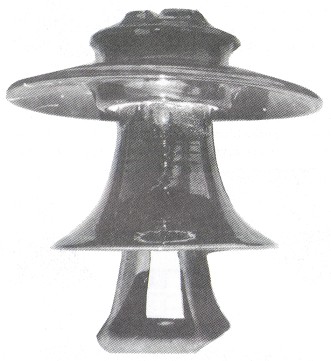
M-2996 N-N Thomas
14 - 9.5 x 10.5
Bill Rohde (NIA # 1219) reported a M-2260 with an interesting Thomas marking.
The one I got from Bill has a dark mottled top with rust/mustard colored bottom
skirt. The glaze dates the insulator sometime between 1908 to 1915 which is a
period that Thomas did not seem to mark their insulators with THOMAS. One
exception are a few M-4325's with a pretty rust/mustard glaze and a large incuse
THOMAS marking on the crown. The earliest THOMAS marking is found on three
white-glazed specimens of U-936 (circa 1902-1907). These have a rather large incuse THOMAS
marking on the side of the crown. The THOMAS marking on M-2260 is much smaller
and appears to be an ink marking similar to what you would find on the four
Lima-manufactured M-2640's with "Lima 36" marking and the two M2420's
with "Lima 32". Like the Lima specimens, the THOMAS marking appears to
be an under-glaze ink marking with an almost hand scratched appearance.
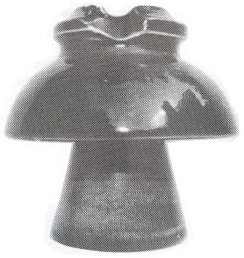
M-2260 with unusual
THOMAS marking.
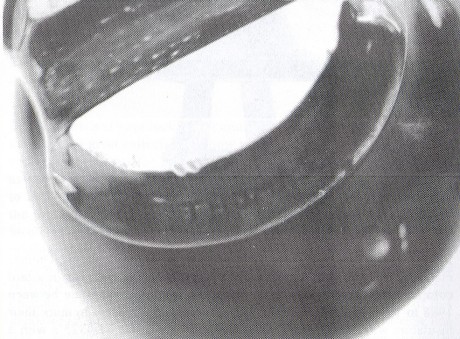
M-2260: Note that the glaze is thicker in the
marking making the letters
appear to be black ink.
Under
strong sunlight you can see slight depressions in the glaze over the marking
which indicates the marking is incuse (struck into the clay). The glaze fills in
the marking depressions where it is thicker than in other areas. The thicker glaze in the marking highlights the letters making
them appear almost black. This type of marking would work fairly well with thin
dark brown glazes that were used in the early years; however, thicker, more
uniform glazes were soon developed which would act to hide the shallow-struck
THOMAS marking. It is my guess that a larger Thomas marking was soon developed
and used more extensively beginning in the mid-1910' s that left a deeper,
bolder marking in order to prevent the glaze from covering it up and to make the
Thomas name more prominent. Jeff Hogan noted that he has seen this same unique
Thomas marking on a M-2260A and on U-950.
George Nowacki (NIA #5813) is
primarily a glass collector but he has made some noteworthy finds of porcelain
insulators in the last year or two -- M-3060 Fred Locke -- around his home town of
Sudbury, Ontario. George sent me a photograph of two unusual transposition
insulators he found on a newer line which ran adjacent and parallel to the line
where he found the M-3060's. The 2-part insulator, M-2101, was found on a
communication line which had Thomas 3-part insulators above it. The two M-2101's
are unmarked and have a pretty pumpkin-colored glaze. I found this style in an
undated Canadian Porcelain Co. catalog (circa 1920's) and no one has reported
finding a specimen until now. This is the only example of a multipart
transposition insulator that I am aware of and the unusual style makes it quite
unique among multiparts.
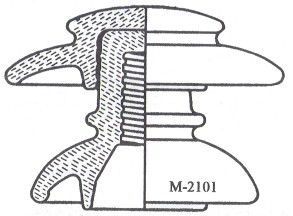
6 - 5 x 4.5
Canadian Porcelain Co.
| 